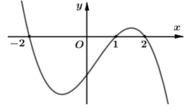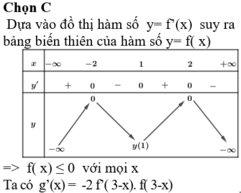Hãy nhập câu hỏi của bạn vào đây, nếu là tài khoản VIP, bạn sẽ được ưu tiên trả lời.

a) Tập xác định : D = R
limx→−∞f(x)=+∞limx→+∞f(x)=−∞y′=−3x2+6x+9=0⇔x=−1,x=3limx→−∞f(x)=+∞limx→+∞f(x)=−∞y′=−3x2+6x+9=0⇔x=−1,x=3
Bảng biến thiên:

Đồ thị hàm số:

b) y=f(x) = f(x) = -x3+3x2+9x+2.
f’(x) = -3x2+6x+9. Do đó:
f’(x-1)=-3(x-1)2+6(x-1)+9
= -3x2 + 12x = -3x(x-4) > 0 ⇔ 0 < x < 4
c) f’’(x) = -6x+6
f’’(x0) = -6 ⇔ -6x0 + 6 = -6 ⇔ x0 = 2
Do đó: f’(2) = 9, f(2) = 24. Phương trình tiếp tuyến của (C) tại x0 = 2 là:
y=f’(2)(x-2) + f(2) hay y = 9x+6

Để kiểm tra một hàm F(x) có phải là một nguyên hàm của f(x) không thì ta chỉ cần kiểm tra F'(x) có bằng f(x) không?
a) \(F\left(x\right)\) là hằng số nên \(F'\left(x\right)=0\ne f\left(x\right)\)
b) \(G'\left(x\right)=2.\dfrac{1}{2}.\dfrac{1}{\cos^2x}=1+\tan^2x\)
c) \(H'\left(x\right)=\dfrac{\cos x}{1+\sin x}\)
d) \(K'\left(x\right)=-2.\dfrac{-\left(\dfrac{1}{2}.\dfrac{1}{\cos^2\dfrac{x}{2}}\right)}{\left(1+\tan\dfrac{x}{2}\right)^2}=\dfrac{\dfrac{1}{\cos^2\dfrac{x}{2}}}{\left(\dfrac{\cos\dfrac{x}{2}+\sin\dfrac{x}{2}}{\cos\dfrac{x}{2}}\right)^2}\)
\(=\dfrac{1}{\left(\cos\dfrac{x}{2}+\sin\dfrac{x}{2}\right)^2}=\dfrac{1}{1+2\cos\dfrac{x}{2}\sin\dfrac{x}{2}}\)
\(=\dfrac{1}{1+\sin x}\)
Vậy hàm số K(x) là một nguyên hàm của f(x).

Câu 1: Điều kiện \(D=\left(-\infty;0\right)U\left(1;+\infty\right)\)
\(y'=\frac{\sqrt{x^2-x}-x.\frac{2x-1}{2\sqrt{x^2-x}}}{x^2-x}=\frac{-x}{2\left(x^2-x\right)\sqrt{x^2-x}}\)
Ta thấy \(y'< 0\) trên \(\left(1;+\infty\right)\), suy ra hàm số nghịch biến trên \(\left(1;+\infty\right)\).
Câu 2:
\(y'=1+\frac{2x}{\sqrt{2x^2+1}}=\frac{2x+\sqrt{2x^2+1}}{\sqrt{2x^2+1}}\)
Xét bất phương trình:
\(2x+\sqrt{2x^2+1}< 0\)
\(\Leftrightarrow\sqrt{2x^2+1}< -2x\)
\(\Leftrightarrow\hept{\begin{cases}x< 0\\2x^2+1< 4x^2\end{cases}}\Leftrightarrow\hept{\begin{cases}x< 0\\x< \frac{-\sqrt{2}}{2}\left(h\right)x>\frac{\sqrt{2}}{2}\end{cases}}\Leftrightarrow x< \frac{-\sqrt{2}}{2}\)
Vậy hàm số nghịch biến trên \(\left(-\infty;\frac{-\sqrt{2}}{2}\right)\).



